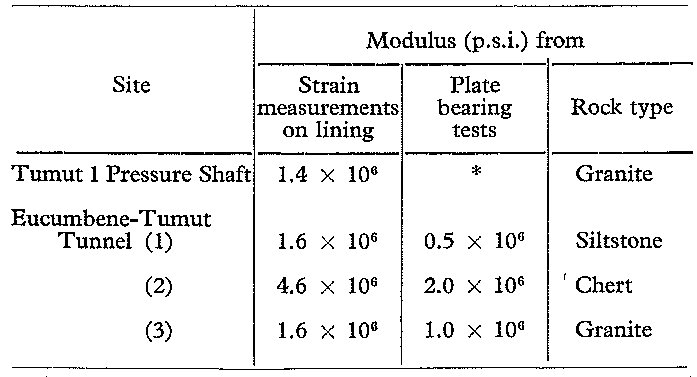Field and Laboratory Tests in Rock Mechanics by L. G. Alexander
The values of modulus obtained from flat jack tests generally range from 100% to 50% of the corresponding modulus obtained from laboratory tests on cores, but values down to 25% are also obtained.
These generally high moduli may be contrasted with the generally low moduli obtained in plate bearing tests, and also those deduced from strain tests on tunnel linings :

*Note: Value not measured but presumed to be in the range 0.6 to 1.7 X IO6, as for (3).
As these moduli are significantly lower than those for sound rock and it is unreasonable to assume that the plate bearing test is representative of the deeper rock, an alternative method of test for the modulus to a reasonable depth around a tunnel, is required.
8.—Tunnel Convergence Test of Modulus
The deformation of a tunnel, in normal operation under water pressure, depends on rock movement to an appreciable depth. Expansion of a tunnel is often tested by subjecting an experimental section of a tunnel to water pressure.
An alternative method of test, in which the depth of rock influenced is similar, was attempted in tests in the Tooma-Tumut tunnel. Measurements were made of the radial convergence of the tunnel caused by the advance of the tunnel heading. The rock stresses were also measured, and the elastic modulus computed from the displacement formula,

which holds for the cutting of a circular hole in a stressed plate, where,
w =
radial displacement of a point in the rock toward the centre of the tunnel,
y =
distance of point from centre of tunnel (taken to be on the vertical line through the centre of the tunnel),
a =
radius of tunnel,
E, μ =
Young’s modulus and Poisson’s ratio of rock,
v =
primary vertical rock stress, and
t =
primary horizontal rock stress perpendicular to the tunnel direction.
(This formula was obtained by the method mentioned in Sec. 5 (theory) for the elliptical hole).
